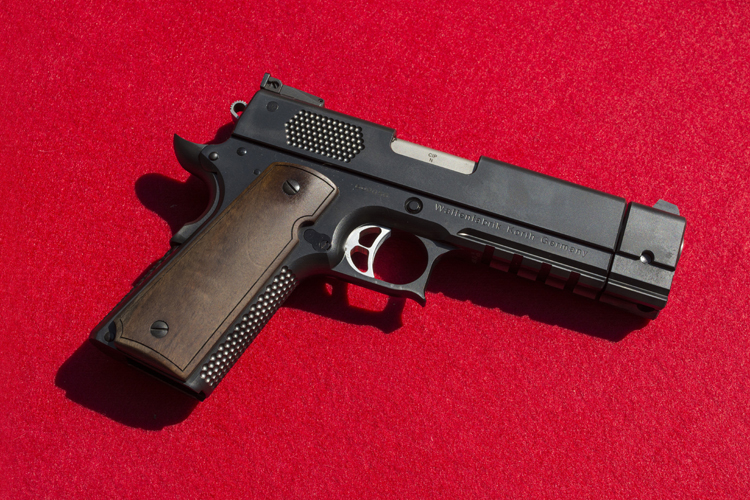
Korth. For some gun aficionados, nothing more needs to be said. Builders in the tradition of ultimate European luxury brands, Korth are perhaps best known for revolvers with price tags that most people would find easier to associate with German cars than German guns. But that out-of-this-world pricing reputation which is the stuff of gun counter lore world wide is derived from their full custom stuff; the entry point is far more accessible. The starting point for a Korth revolver is around the starting point for a Rolex: five thousand dollars will put some of that European goodness in your hands, and it will sure be memorable. Korth revolvers are legendary.
But when Korth debuted the PRS a few years ago, they weren’t just bringing out another revolver which, no matter how incredibly well-constructed, was a fundamentally conventional, proven design. No, the PRS was something entirely new. It looked like a 1911 (or at least a 1911 as imagined by an android with a preference for angles over curves). It was chambered in .45 acp, and fed from 7 round, single stack 1911 magazines. So what’s the big deal? Another piece of high dollar 1911 art; isn’t that done to death at this point?
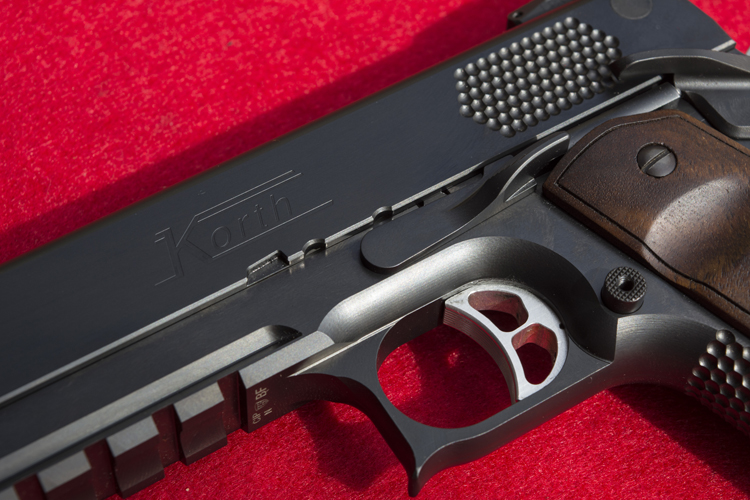 But this is not a 1911 at all. There is no Browning tilt-barrel short recoil system here; the very operating system named for the 1911’s designer has been replaced, and that most American of designs has been replaced with the most German possible alternative: roller-delayed blowback. Are you ready to step through the teutonic looking glass?
But this is not a 1911 at all. There is no Browning tilt-barrel short recoil system here; the very operating system named for the 1911’s designer has been replaced, and that most American of designs has been replaced with the most German possible alternative: roller-delayed blowback. Are you ready to step through the teutonic looking glass?
 A brief explanation of each recoil system is perhaps warranted here. The Browning design in the 1911 uses the rearward impulse of the gun's discharge to drive both barrel and slide back together, but the barrel very quickly engages the link and rotates downwards, tilting away from the slide and disengaging the barrel lugs from the slide lugs, allowing the slide to continue its rearward travel far enough to open the ejection port fully, toss out the spent brass, and pick up a new bullet from the magazine. The slide drives the cartridge forward, and close to the end of the forward travel the slide contacts the barrel and drives it forward, re-engaging the lugs as the barrel tilts back to horizontal.
A brief explanation of each recoil system is perhaps warranted here. The Browning design in the 1911 uses the rearward impulse of the gun's discharge to drive both barrel and slide back together, but the barrel very quickly engages the link and rotates downwards, tilting away from the slide and disengaging the barrel lugs from the slide lugs, allowing the slide to continue its rearward travel far enough to open the ejection port fully, toss out the spent brass, and pick up a new bullet from the magazine. The slide drives the cartridge forward, and close to the end of the forward travel the slide contacts the barrel and drives it forward, re-engaging the lugs as the barrel tilts back to horizontal.
The upsides to a Browning-style tilting barrel are fairly clear: one way or another, the barrel has to separate from the slide, so tilting the barrel clears it easily. There aren’t a lot of moving parts, and the leap that the cartridge has to make from the top spot in the magazine to the chamber is reduced, as the barrel tilts into a closer position.
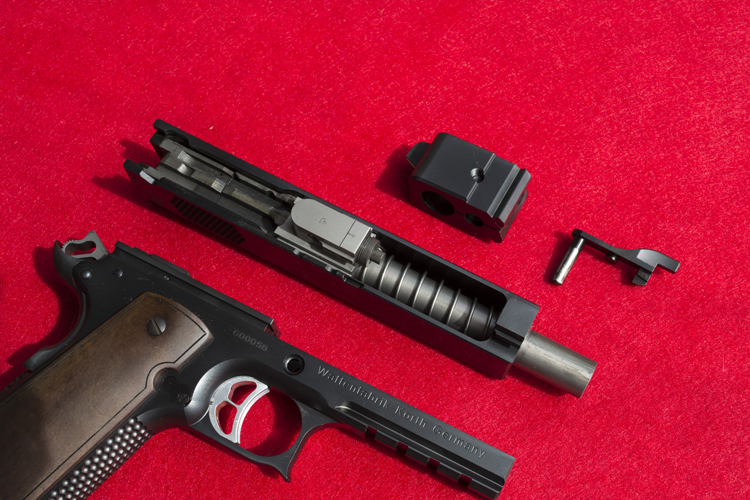 The downsides are also fairly notable. Most importantly, perhaps, is that while there aren’t a lot of moving parts, the parts that are moving are really important ones, like the barrel. Imagine if your favourite rifle had a barrel that had to flop around loosely, independent of the receiver, between each shot. How do you feel about the impact that’s going to have on accuracy?
The downsides are also fairly notable. Most importantly, perhaps, is that while there aren’t a lot of moving parts, the parts that are moving are really important ones, like the barrel. Imagine if your favourite rifle had a barrel that had to flop around loosely, independent of the receiver, between each shot. How do you feel about the impact that’s going to have on accuracy?
Fortunately, for every mechanical problem, there is an engineer out there somewhere working on a solution, and this solution was first attempted in the Sturmgewehr 45M. Now, we’ve taken some flak for our random mockery of communists, so this seems as good a time as any to take a poke at some of the worst socialists in history: the National Socialists. Yes, the Nazis were so utterly morally bankrupt that not even some of the most fascinating arms design in history could help save their depraved empire, which is now celebrated only by tiny groups of disturbed individuals who, apparently, don’t enjoy being on the side that actually won. But enough about the grotesque, murderous, all-powerful state that lost to (among others) people armed with two-dollar Liberator pistols; let’s get back to the engineering.
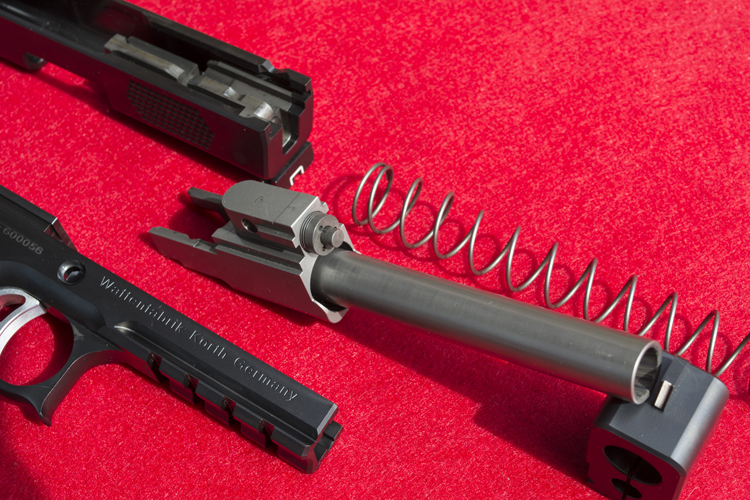 The roller delayed blowback which Mauser had prototyped in the Stg. 45M made it into production in the form of the German-designed, Spanish-built CETME Model 58, more commonly known simply as the CETME, the SIG SG 510, and, two years later and perhaps most famously, the Heckler und Koch G3 and later MP5. Yes, it’s very German.
The roller delayed blowback which Mauser had prototyped in the Stg. 45M made it into production in the form of the German-designed, Spanish-built CETME Model 58, more commonly known simply as the CETME, the SIG SG 510, and, two years later and perhaps most famously, the Heckler und Koch G3 and later MP5. Yes, it’s very German.
The goal of the roller delay system is to allow a simple blowback operation to the gun, without having to make the bolt heavy to keep the chamber closed during firing through pure inertia. Instead, the bolt is a complex piece of machinery that consists, in part, of the breech face section which houses two rollers being driven outward into recesses machined into the slide, and a rear carrier which includes a wedge-shaped extension which is keeping those rollers held into their recesses when the slide is fully forward.
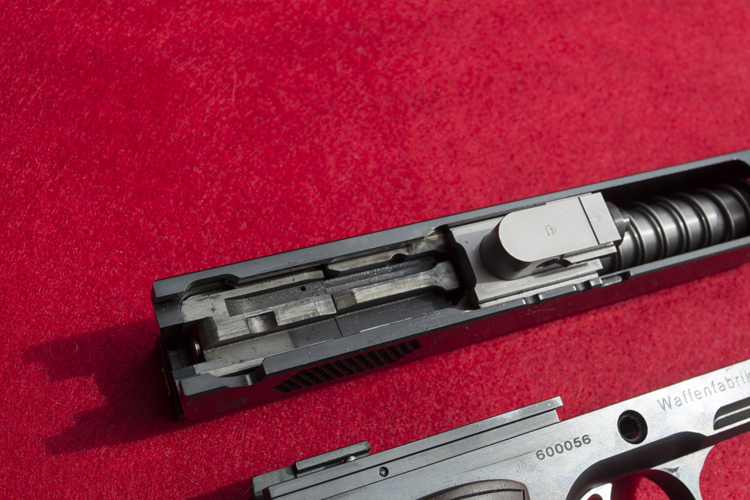 When the gun is fired, the carrier moves back immediately with the slide, withdrawing the wedge slightly. The rollers on the breech face section, which is pinned to the carrier through a slotted cutout to allow a couple of millimetres of travel, are now free to retract and ride inwards on the sloped lands of their recesses. When the breechface section runs out of travel and begins to move back with the carrier and slide, the rollers are no longer delaying the action from opening and the entire assembly moves backwards, extracting and ejecting the old brass, and picking up a new round on the way forward.
When the gun is fired, the carrier moves back immediately with the slide, withdrawing the wedge slightly. The rollers on the breech face section, which is pinned to the carrier through a slotted cutout to allow a couple of millimetres of travel, are now free to retract and ride inwards on the sloped lands of their recesses. When the breechface section runs out of travel and begins to move back with the carrier and slide, the rollers are no longer delaying the action from opening and the entire assembly moves backwards, extracting and ejecting the old brass, and picking up a new round on the way forward.
Advantages and disadvantages of the roller delayed blowback are, essentially, the reverse of the Browning tilt-barrel. The complexity of the system is fairly apparent: the two-part bolt and the rollers and everything in there means a lot of parts and pins and machining. But in the entire description of moving parts, what is conspicuously absent? The barrel. In a blowback gun, the barrel is often fixed. Remember the rifle with the moving barrel? A blowback gun can simply be a rifle. Accuracy with a barrel that stays in place is much, much easier to achieve.
Well, the theory is well established. The roller delayed blowback ought to be extremely accurate, and certainly the 1911 has taken its share of knocks from people who complain about its reliability. Is this linkless, stationary barrel the answer?
We set up with a dozen magazines from three different manufacturers, and factory ammo from Remington, Federal, and Winchester, and began to shoot.
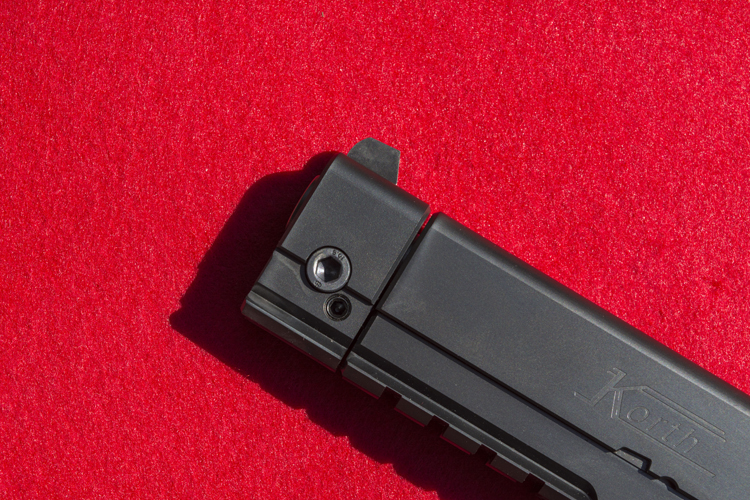 Well, one thing we can tell you: the accuracy, even by 1911 standards, is superb. The recoil is very gentle; the trigger gives up nothing to any custom manufacturer and breaks cleanly at around two and a half pounds. The trigger, disconnector, hammer and sear are all straight-up 1911 parts so there’s no mistaking the feel of either the break or the reset and the mechanics of achieving excellence on both are well understood. It shows. Rested, we could shoot groups just over an inch at 25 yards.
Well, one thing we can tell you: the accuracy, even by 1911 standards, is superb. The recoil is very gentle; the trigger gives up nothing to any custom manufacturer and breaks cleanly at around two and a half pounds. The trigger, disconnector, hammer and sear are all straight-up 1911 parts so there’s no mistaking the feel of either the break or the reset and the mechanics of achieving excellence on both are well understood. It shows. Rested, we could shoot groups just over an inch at 25 yards.
But one thing we can tell you is that the Korth PRS is clearly designed to run in narrow operating envelopes. It is supplied with three different recoil springs, and if you want to maximize your performance you will need to spend some time learning what ammunition and magazine work the best with what spring. We found, for example, that with the “strong” recoil spring in place, Wilson 47D magazines with fresh springs worked quite well with American Eagle 230 grain FMJ, but Remington UMC would occasionally hang in the feed path, despite being nearly identical.
 Similarly, older 47D magazines, Chip McCormicks, and Checkmates would all give failures to feed on the strongest recoil spring. The “medium” recoil spring is much more forgiving, slowing down the slide’s return to battery enough that the gun becomes more tolerant of varying ammunition, although we still had occasional glitches from Checkmate magazines, in particular with Winchester white box 230 grain FMJ.
Similarly, older 47D magazines, Chip McCormicks, and Checkmates would all give failures to feed on the strongest recoil spring. The “medium” recoil spring is much more forgiving, slowing down the slide’s return to battery enough that the gun becomes more tolerant of varying ammunition, although we still had occasional glitches from Checkmate magazines, in particular with Winchester white box 230 grain FMJ.
Running the American Eagle from the legendary 47Ds turned the Korth PRS from a tack driver that would periodically, and unpredictably, refuse to feed, into a soft-shooting laser beam of power. Whether that combination would always be the answer, we’re not entirely sure; the PRS we were playing with is brand new, and it’s difficult to predict whether the recoil or main spring would settle down a bit and change the gun’s preferences, thus reducing the need for the fairly freshly-sprung magazines. That’s fairly probable, but it’s difficult to know for sure. At present, it appears that the the slide returns to battery so quickly that the bullets are stripped pretty aggressively out of the magazine, so cheap mags with vague feed path angles are not going to be your best option here.
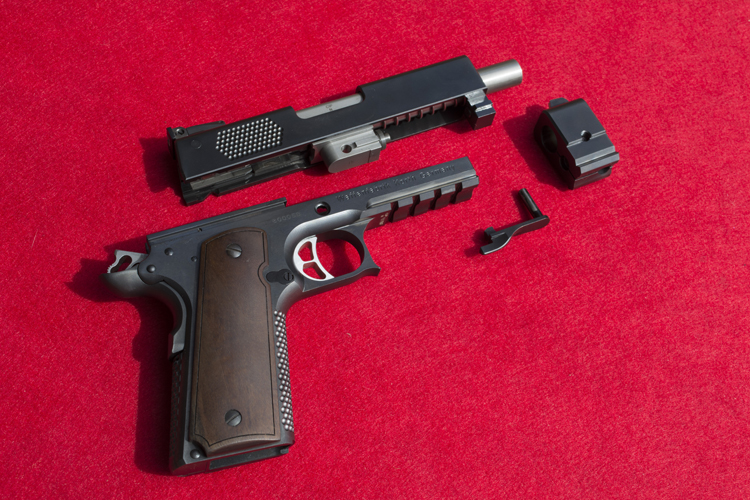 On the other hand, if you buy a Korth PRS and expect to use cheap magazines full of bulk surplus ammo, we don’t really understand why you chose the gun in the first place. It’s not there to be a cheap plinker; this is a four-and-three-quarter thousand dollar statement piece for collectors who want to revel in luxury. Please do not take your Maybach to Walmart for new tires; please do not buy a Korth and then complain that it cost you five boxes of ammo to figure out its ideal combination. This is thin-end-of-the-wedge gun collector exotica and if you’d rather just have a Glock, do yourself a favour and buy one.
On the other hand, if you buy a Korth PRS and expect to use cheap magazines full of bulk surplus ammo, we don’t really understand why you chose the gun in the first place. It’s not there to be a cheap plinker; this is a four-and-three-quarter thousand dollar statement piece for collectors who want to revel in luxury. Please do not take your Maybach to Walmart for new tires; please do not buy a Korth and then complain that it cost you five boxes of ammo to figure out its ideal combination. This is thin-end-of-the-wedge gun collector exotica and if you’d rather just have a Glock, do yourself a favour and buy one.
If the statement the Korth PRS makes is something that interests you, however, it can hang with the best pistols we've ever seen, accuracy-wise. This is one of the first pistols we’ve ever seen that made us start thinking about precision handloading for a handgun; it may be the first “service” pistol to warrant benchrest ammo. So there is definitely an exotic form of fun available to be had by shooting it.
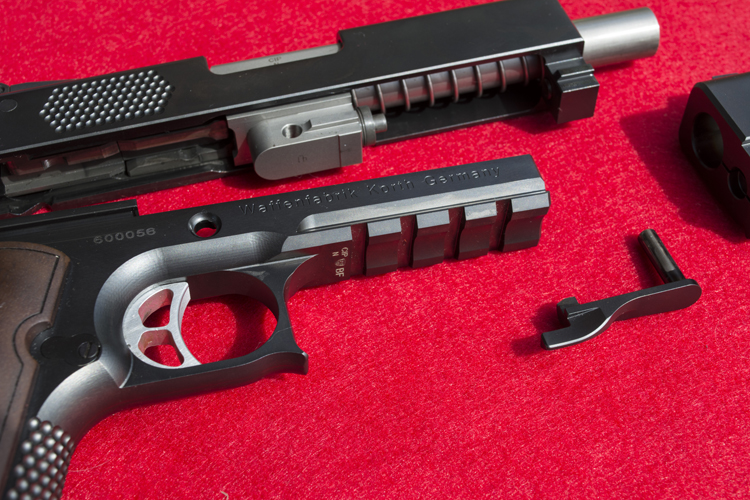 But we wouldn’t dismiss the fun had simply by showing it to others, either. We showed it off plenty, and it never stopped being fun. Collectors take note: this is hands down one of the strangest, most interesting firearms to ever cross our desks, and shooting it is a rare privilege indeed.
But we wouldn’t dismiss the fun had simply by showing it to others, either. We showed it off plenty, and it never stopped being fun. Collectors take note: this is hands down one of the strangest, most interesting firearms to ever cross our desks, and shooting it is a rare privilege indeed.